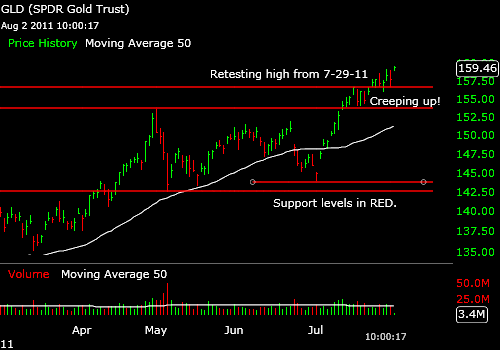Looking At The Best Gold Etfs For The Novice Investor
An exchange-traded fund (ETF) is an investment vehicle that allows small-scale retail investors to buy or sell financial products that originate from a set of investment assets that has been acquired by a large-scale institutional investor from the owner or manager of these assets. It is important to remember that exchange-traded funds that deal in gold (gold ETFs) are a type of commodity ETF, which in turn is a specific type of ETF that is not subject to the regulations that cover ETFs that deal in securities.
Commodity ETFs, just like other ETFs, are traded daily on an exchange in the same way as stocks and bonds. In the United States, the trading in some commodity ETFs (and by extension some gold ETFs) are sometimes subject to oversight by the Commodity Futures Trading Commission (CFTC). This is seen to be a positive developed for the consumer particularly with the recent scandals that have plagued Wall Street.
What Are Gold Exchanged Traded Funds?
 Some gold ETFs in the USA, however, are not subject to oversight by the Commodity Futures Trading Commission nor by the Securities and Exchange Commission (SEC). For example, the largest-by-volume gold ETF available in the United States (SPDR Gold Shares/Trust) is not subject to CFTC oversight because it is not a commodity pool (mutual fund). It not even subject to SEC regulation because it is (also) not an “investment company” as defined by the Investment Company Act of 1940.
Some gold ETFs in the USA, however, are not subject to oversight by the Commodity Futures Trading Commission nor by the Securities and Exchange Commission (SEC). For example, the largest-by-volume gold ETF available in the United States (SPDR Gold Shares/Trust) is not subject to CFTC oversight because it is not a commodity pool (mutual fund). It not even subject to SEC regulation because it is (also) not an “investment company” as defined by the Investment Company Act of 1940.
A retail investor needs to look closely into the prospectuses of gold ETFs before making the decision to participate in their trades. Each gold ETF has a distinct set of risks and tax requirements that are generally transferred to or shouldered exclusively by the retail investor. In the U.S., gold ETF transactions are considered as commodity transactions and are accordingly charged with a 28% capital-gains tax.
Advantages And Disadvantages
Although holding gold ETFs is generally less expensive (and can have greater short-term profitability) than owning large quantities of physical gold, they inherently carry more risks than physical gold investments. Also, the amount of physical gold in each gold ETF share gradually diminishes over time throughout the lifetime of the fund.
The best gold ETFs, from a quality-based perspective, would be those that allow redemption of shares in actual physical gold (in addition to cash) without prohibitive redemption fees. Precious Metals Bullion Trust is a good example of this kind of “safer” actual-physical-gold-based ETF investment.
Most Well Know And Respected Gold Etfs
Based on the amount of reported gold holdings or assets, the top-five most popular gold ETFs in the USA include SPDR Gold Trust, iShares COMEX Gold Trust, ETFS Gold Trust, DB Gold Double Long ETN, and PowerShares DB Gold Fund.
SPDR Gold Trust is sponsored by a wholly-owned subsidiary of the World Gold Council (a Swiss-registered non-profit entity) and the shares are marketed/issued by State Street Global Markets, LLC. It is an index-type ETF that was intended to follow the spot price of gold bullion. This ETF has an expense ratio of 0.40%. The current price per share is $153.56. It’s latest market capitalization figure is US$64.93 billion, with the shares held by investors numbering to about 422,000,000.
iShares COMEX Gold Trust is marketed/issued by iShares . It is also an index-type ETF that was designed to follow the spot price of gold bullion. This ETF has an expense ratio of 0.25%, and a current price per share of $15.41. This fund has a market capitalization of US$9.52 billion and shares outstanding of 594,450,000.
ETFS Physical Swiss Gold Trust is issued by ETF Securities, and is also an index-type ETF designed to follow the spot price of gold bullion. This ETF has an expense ratio of 0.39%, and a current price per share of $156.50. DB Gold Double Long ETN is issued by Invesco and is designed to track a combination of gold futures contracts and 3-month US Treasury Bills. It has an expense ratio of 0.75%, and a current price per share of $47.50. PowerShares DB Gold Fund is also issued by Invesco. This fund has an expense ratio of 0.50%. It is based on an index of gold futures contracts. The latest available share price was $54.67.
The Best Etfs
A more complete gold ETFs list can be found on various websites on the web. Online gold ETF lists categorize ETFs by type, country, holdings volume, expenses, return rates, and so on.
A list of the top 15 ETFs from according to etfdb.com (an online etf database) is reproduced below for your reference:
1. SPDR – Gold Trust (GLD)
2. iShares – COMEX Gold Trust (IAU)
3. ETFS – Physical Swiss Gold Trust (SGOL)
4. DB – Gold Double Long ETN (DGP)
5. PowerShares – DB Gold Fund (DGL)
6. ProShares – Ultra Gold (UGL)
7. ProShares – UltraShort Gold (GLL)
8. DB – Gold Double Short ETN (DZZ)
9. ETFS – Physical Asian Gold Shares (AGOL)
10. DB – Gold Short ETN (DGZ)
11. Velocity-Shares 3x Long Gold ETN linked to the S&P GSCI Gold Index ER (UGLD)
12. RBS – Gold Trendpilot ETN (TBAR)
13. Factor – Shares 2X (FSG)
14. UBS E-TRACS CMCI Gold Total Return ETN (UBG)
15. Velocity-Shares 3x Inverse Gold ETN linked to S&P GSCI Gold Index Excess Return (DGLD)
Of course etfs are not the only way you can get into the gold market, have a look at our post on other ways to invest in gold here. You may choose one, two or several types of gold investment vehicles to diverse your portfolio.









